
Concept explainers
(a)
Interpretation:
The product formed when
Concept Introduction:
Pyridine is a heterocyclic compound which contains nitrogen atom. Pyridine nitrogen atom contain a lone pair. The lone pair of pyridine is not involved in the resonance with the
Answer to Problem 26.27AP
The product formed when
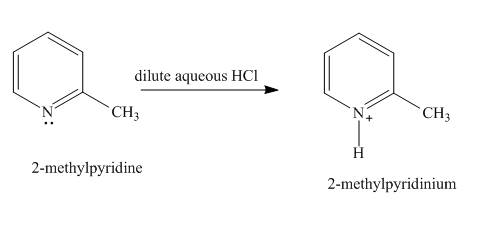
Explanation of Solution
In the given compound, the lone pair of the pyridine nitrogen is not involved in the resonance with the ring. Pyridine acts as base in the presence of acid. The nitrogen abstracts the proton from acid. The product formed is

Figure 1
The product formed in the given reaction is
(b)
Interpretation:
The product formed when
Concept Introduction:
Pyridine is a heterocyclic compound which contains nitrogen atom. Pyridine nitrogen atom contain a lone pair. The lone pair of pyridine is not involved in the resonance with the aromatic ring. No delocation of electron takes place, hence pyridine acts as a base. The hydrogen atoms of pyridine ring are not highly acidic, so mild base can’t abstract proton from pyridine. It requires a strong base for abstraction of proton.
Answer to Problem 26.27AP
No reaction takes place when
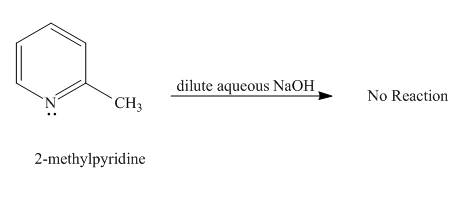
Explanation of Solution
Protons of pyridine are not highly acidic in nature. Sodium hydroxide cannot abstract proton from pyridine. It requires a very strong base for the removal of proton from pyridine to takes place. Hence, no reaction takes place between

Figure 2
No product is formed in the given reaction.
(c)
Interpretation:
The product formed when
Concept Introduction:
Pyridine is a heterocyclic compound which contains nitrogen atom. Pyridine nitrogen atom contain a lone pair. The lone pair of pyridine is not involved in the resonance with the aromatic ring. No delocation of electron takes place, hence pyridine acts as a base. The hydrogen atoms of pyridine ring are not highly acidic, so mild base can’t abstract proton from pyridine. It requires a strong base for abstraction of proton.
Answer to Problem 26.27AP
The product formed when

Explanation of Solution
The butyl-lithium compound is a very strong base. It will abstract proton from the methyl group of

Figure 3
The product formed in the given reaction is
(d)
Interpretation:
The product formed when
Concept Introduction:
Nitration reaction is aromatic electrophilic substitution reaction. The nitrating mixture contains nitric acid and sulfuric acid. The nitrosonium ion is formed as electrophile. The methyl group is an activating group, so it promotes electrophilic substitution reaction at ortho-para position.
Answer to Problem 26.27AP
The product formed when

Explanation of Solution
The compound

Figure 4
The product formed in the given reaction is
(e)
Interpretation:
The product formed when
Concept Introduction:
Pyridine is a heterocyclic compound which contains nitrogen atom. Pyridine nitrogen atom contain a lone pair. The lone pair of pyridine is not involved in the resonance with the aromatic ring. Hydrogen peroxide is a strong oxidizing agent. It will oxidize the nitrogen atom of pyridine to form
Answer to Problem 26.27AP
The product formed when
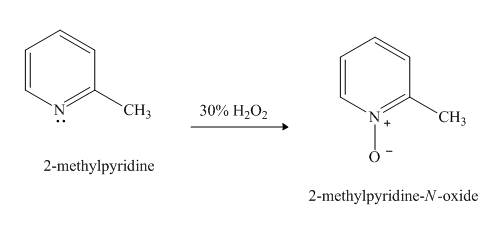
Explanation of Solution
Hydrogen peroxide is an oxidizing agent. It will oxidize the given compound. The oxidation reaction takes place at the nitrogen atom.

Figure 5
The product formed in the given reaction of
(f)
Interpretation:
The product formed when
Concept Introduction:
Pyridine is a heterocyclic compound which contains nitrogen atom. Pyridine nitrogen atom contain a lone pair. The lone pair of pyridine is not involved in the resonance with the aromatic ring. No delocation of electron takes place, hence pyridine acts as a base. The nitrogen atom lone pair attacks the methyl group of methyl iodide.
Answer to Problem 26.27AP
The product formed when
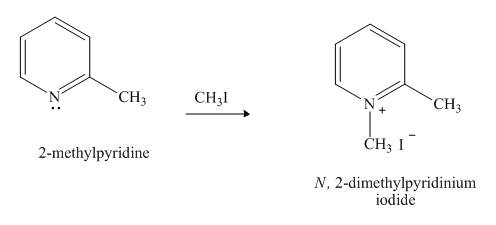
Explanation of Solution
The lone pair of nitrogen atom of pyridine is not involved in the resonance with the aromatic ring. The lone pair makes the pyridine compound basic in nature. When compound

Figure 6
The product formed in the given reaction of
(g)
Interpretation:
The product formed when
Concept Introduction:
Pyridine is a heterocyclic compound which contains nitrogen atom. Pyridine nitrogen atom contain a lone pair. The lone pair of pyridine is not involved in the resonance with the aromatic ring. No delocation of electron takes place, hence pyridine acts as a base. Lithiated pyridine compound reacts with
Answer to Problem 26.27AP
The product formed when
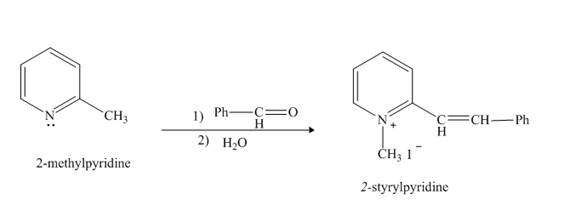
Explanation of Solution
The lithiation product formed reacts with benzaldehyde, nucleophilic addition reaction takes place to form

Figure 7
The product formed when
(h)
Interpretation:
The product formed when
Concept Introduction:
Pyridine is a heterocyclic compound which contains nitrogen atom. Pyridine nitrogen atom contain a lone pair. The lone pair of pyridine is not involved in the resonance with the aromatic ring. Hydrogen peroxide is a strong oxidizing agent. It will oxidize the nitrogen atom of pyridine to form
Answer to Problem 26.27AP
The product formed when
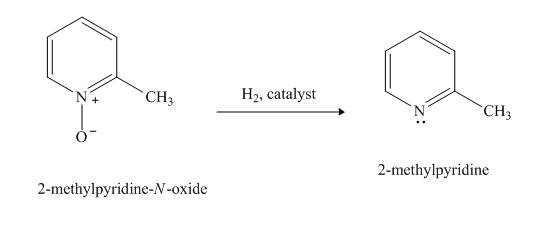
Explanation of Solution
The compound

Figure 8
The product formed when
Want to see more full solutions like this?
Chapter 26 Solutions
EBK ORGANIC CHEMISTRY STUDY GUIDE AND S
- Determine the structures of the missing organic molecules in the following reaction: X+H₂O H* H+ Y OH OH Note: Molecules that share the same letter have the exact same structure. In the drawing area below, draw the skeletal ("line") structures of the missing organic molecules X and Y. You may draw the structures in any arrangement that you like, so long as they aren't touching. Click and drag to start drawing a structure. X Sarrow_forwardPredict the major products of this organic reaction. If there aren't any products, because nothing will happen, check the box under the drawing area instead. No reaction. HO. O :☐ + G Na O.H Click and drag to start drawing a structure. XS xs H₂Oarrow_forwardWhat are the angles a and b in the actual molecule of which this is a Lewis structure? H H C H- a -H b H Note for advanced students: give the ideal angles, and don't worry about small differences from the ideal groups may have slightly different sizes. a = b = 0 °arrow_forward
- What are the angles a and b in the actual molecule of which this is a Lewis structure? :0: HCOH a Note for advanced students: give the ideal angles, and don't worry about small differences from the ideal that might be caused by the fact that different electron groups may have slightly different sizes. a = 0 b=0° Sarrow_forwardDetermine the structures of the missing organic molecules in the following reaction: + H₂O +H OH O OH +H OH X Note: Molecules that share the same letter have the exact same structure. In the drawing area below, draw the skeletal ("line") structure of the missing organic molecule X. Click and drag to start drawing a structure.arrow_forwardIdentify the missing organic reactant in the following reaction: x + x O OH H* + ☑- X H+ O O Х Note: This chemical equation only focuses on the important organic molecules in the reaction. Additional inorganic or small-molecule reactants or products (like H₂O) are not shown. In the drawing area below, draw the skeletal ("line") structure of the missing organic reactant X. Click and drag to start drawing a structure. Carrow_forward
- CH3O OH OH O hemiacetal O acetal O neither O 0 O hemiacetal acetal neither OH hemiacetal O acetal O neither CH2 O-CH2-CH3 CH3-C-OH O hemiacetal O acetal CH3-CH2-CH2-0-c-O-CH2-CH2-CH3 O neither HO-CH2 ? 000 Ar Barrow_forwardWhat would be the best choices for the missing reagents 1 and 3 in this synthesis? 1. PPh3 2 2. n-BuLi 3 Draw the missing reagents in the drawing area below. You can draw them in any arrangement you like. • Do not draw the missing reagent 2. If you draw 1 correctly, we'll know what it is. • Note: if one of your reagents needs to contain a halogen, use bromine. Explanation Check Click and drag to start drawing a structure.arrow_forwardPredict the products of this organic reaction: NaBH3CN + NH2 ? H+ Click and drag to start drawing a structure. ×arrow_forward
- Predict the organic products that form in the reaction below: + OH +H H+ ➤ ☑ X - Y Note: You may assume you have an excess of either reactant if the reaction requires more than one of those molecules to form the products. In the drawing area below, draw the skeletal ("line") structures of the missing organic products X and Y. You may draw the structures in any arrangement that you like, so long as they aren't touching. Click and drag to start drawing a structure. Garrow_forwardPredict the organic products that form in the reaction below: OH H+ H+ + ☑ Y Note: You may assume you have an excess of either reactant if the reaction requires more than one of those molecules to form the products. In the drawing area below, draw the skeletal ("line") structures of the missing organic products X and Y. You may draw the structures in any arrangement that you like, so long as they aren't touching. Click and drag to start drawing a structure. ✓ marrow_forwardDetermine the structures of the missing organic molecules in the following reaction: + H₂O +H H+ Y Z ☑ ☑ Note: Molecules that share the same letter have the exact same structure. In the drawing area below, draw the skeletal ("line") structures of the missing organic molecules X, Y, and Z. You may draw the structures in any arrangement that you like, so long as they aren't touching. Molecule X shows up in multiple steps, but you only have to draw its structure once. Click and drag to start drawing a structure. AP +arrow_forward
 Chemistry: Principles and ReactionsChemistryISBN:9781305079373Author:William L. Masterton, Cecile N. HurleyPublisher:Cengage Learning
Chemistry: Principles and ReactionsChemistryISBN:9781305079373Author:William L. Masterton, Cecile N. HurleyPublisher:Cengage Learning

